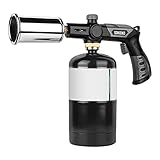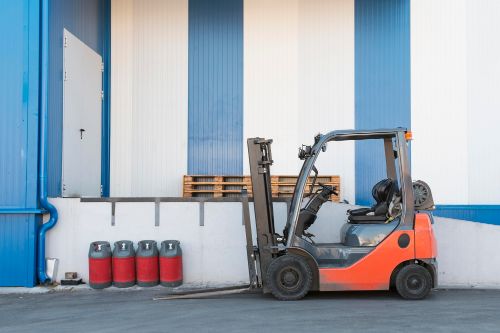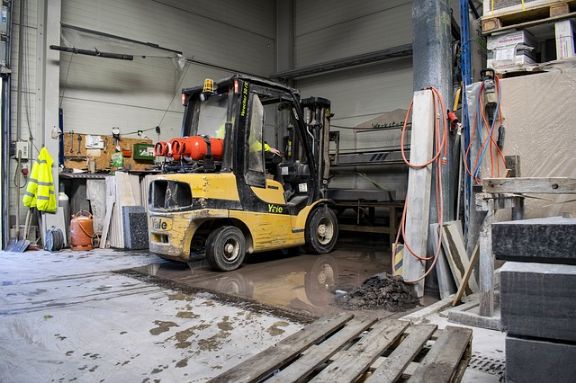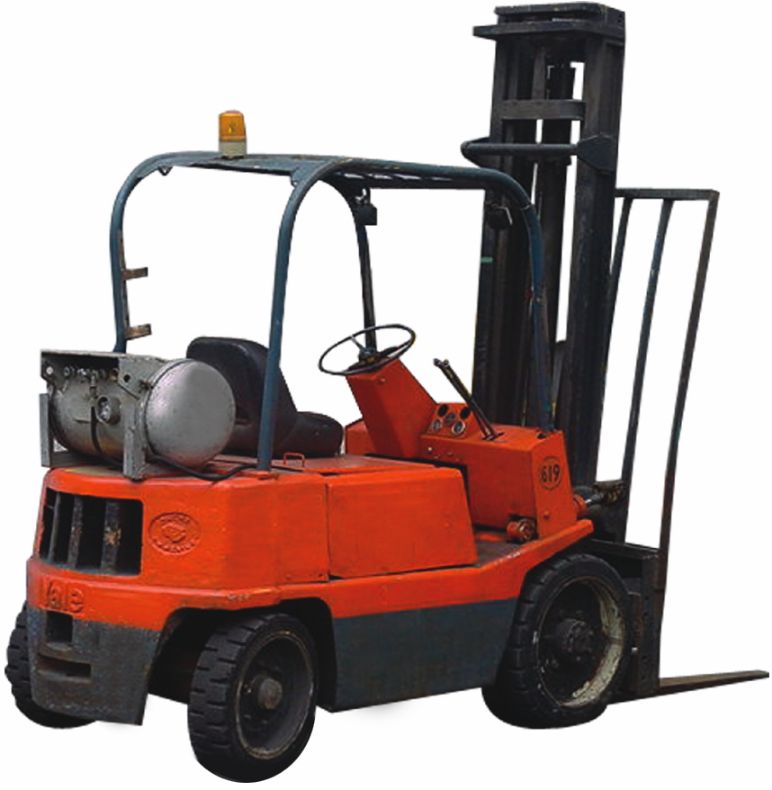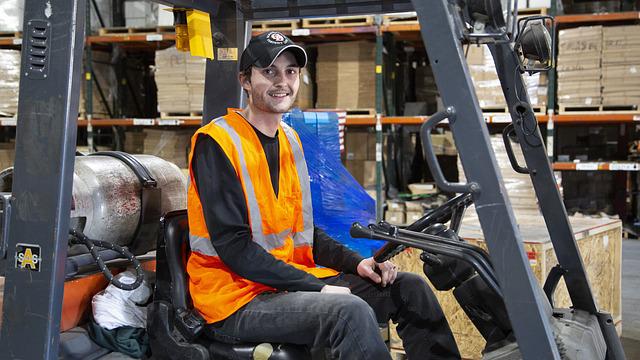
I read from a number of online forums and have learned from a co-worker (but did not try it yet) that you can use a regular propane tank on a forklift. I even heard that from a neighbor he was able to hook up a regular propane tank onto this equipment.
That would not be true. Because the fittings and fixtures on the forklift tank are different from an ordinary propane tank. Likewise, some models of propane-powered forklifts draw liquid propane from the tank and don’t run on vapor only. Besides doing so is a safety risk that should not be attempted under any circumstances.
No expert would give the advice of using a regular propane tank on a forklift because of the inherent danger in doing such. And even if you have an adapter that fits, that would not still be appropriate. You just risk getting into a serious accident or damaging precious equipment.
Don’t try it, there is too much that could go wrong.
Handling propane tanks is a dangerous undertaking. It is crucial for everyone to follow and adhere to basic safety guidelines in order to avoid untoward accidents such as explosions that could lead to injury or damage to property.
 |      |      |      |
If You Cannot Use, Where Do These Tanks Differ Then?
- They differ in assembly – forklift tanks have excess flow valves, liquid gaging devices, safety relief devices, and protective housing – regular tanks don’t have these fixtures.
- Tanks differ in orientation – forklift tanks are positioned horizontally; in this position, propane runs in dip tubing into the vaporizer and into the IC motor of the equipment. On the other hand, regular tanks can only be positioned vertically, otherwise propane gas comes out of the valve.
- They differ in the discharge of propane – regular tanks release vapor while forklift tanks discharge liquid propane. If you use it the other way around on an appliance, it is a failure – you just risk getting exposed to the chemical or involve in an accident.
- They differ in pressure discharge – a forklift tank dispenses gas at a higher pressure than a regular cylinder; and therefore when you install it in another appliance such as a grill, the regulator may not work properly, the said appliance may catch fire. You don’t want this to happen, do you?
- Forklift tanks release liquid propane while ordinary ones release vapor. As part of the engine manifold of the IC engine, the liquid, after getting discharged from the cylinder, goes to the liquid regulator and into the vaporizer for combustion. In an ordinary tank, only vapor regulators regulate the discharge.
- The valve threads are of different sizes. Liquid valves (forklift cylinders) have a larger size than vapor valves (ordinary bottles). The latter can be used on other appliances such as a grill, buffer, cooker, or generator while the former can only be used on a forklift.
| Aspect | Regular Propane Tank | Forklift Propane Tank |
|---|---|---|
| Design | Typically designed with a single valve that can lead to fuel spillage if not carefully handled. | Specifically designed for forklift use with multiple valves and a liquid withdrawal valve that prevents fuel spillage. |
| Safety | Lower safety standard as it’s intended for less hazardous applications, such as grills or heaters. May lead to safety risks when used on a forklift due to non-regulated release of propane. | Higher safety standards with built-in safety valves and fittings that control the propane’s release, reducing the risk of accidents. |
| Efficiency | May reduce the forklift’s efficiency due to inconsistent fuel supply and potential for spillage. | Designed to optimize forklift performance by maintaining a consistent and regulated fuel supply. |
| Regulatory Compliance | Using a regular propane tank for a forklift may violate OSHA standards, leading to potential legal implications. | Meets OSHA regulations and standards for forklift usage, ensuring your operation remains compliant with safety laws. |
| Durability | Not designed to withstand the rugged conditions of a forklift operation. | Made with durable materials to withstand harsh operational conditions. |
| Orientation | Designed for vertical use, which could cause issues when mounted horizontally on a forklift. | Designed for horizontal use to suit the forklift’s design. |
| Cost | May seem cost-effective initially but can lead to higher maintenance costs and potential fines for non-compliance with safety standards. | Although higher in upfront cost, provides better value over time due to improved efficiency, safety, and regulatory compliance. |
They Differ On These Aspects as Well
| Criteria | Regular Propane Tanks | Forklift Propane Tanks |
|---|---|---|
| Shape | Cylindrical with a rounded end, designed for upright usage. | Squat and horizontal design, mounted to the side of the forklift. |
| Size | Vary from small portable tanks to large tanks. Common sizes range from 20 to 100 pounds or more. | Standardized to fit typical forklift models, often between the 33-pound to 43-pound range. |
| Pressure Valve | Designed for static, residential, or light commercial use. | Heavy-duty pressure relief valves that can withstand forklift operations. |
| Release Valve | Usually have a single valve for filling and attaching to an appliance. | Dual valve system with one for refilling and a quick-connect type for the forklift. |
| Material & Thickness | Constructed from steel or aluminum. Might not be as thick or durable as industrial tanks. | Built rugged with thicker walls. Might have additional protective features or coatings. |
| Protection & Coatings | Basic paint or coating to prevent rust and corrosion. | Rust-resistant coatings with potential additional protective guards or insulation. |
Government Regulations that Prohibit the Use of Regular Propane Tanks for Other Purposes
The regulations for propane tanks vary from state to state but there are some federal regulations that apply across all states:
OSHA Standard 1910.110 – Storage and Handling of Liquefied Petroleum Gases
- 1910.110(b)(3) – Requirements for construction and original test of containers
- 1910.110(b)(4) – Welding of containers
- 1910.110(b)(7) – Container valves and container accessories
- 1910.110(b)(8) – Piping – including pipe, tubing, and fittings
Department of Transportation 49 CFR chapter 1
NFPA 58 – Liquefied Petroleum Gas Code
In the US, there are different regulations on propane tanks depending on the state. There are some states with stringent laws as well as some states with no regulations at all. If you have any concerns in the use of propane tanks in the state or city you are in, better to consult the committee or board handling such matter.
Performance and Efficiency Concerns
| Performance and Efficiency Concerns | Regular Propane Tanks | Forklift Propane Tanks |
|---|---|---|
| Possible discrepancies in fuel flow rates | Designed for consistent but relatively low fuel flow rate. Might lead to reduced power, slower operation, or stalling on forklifts. | Designed for high-performance needs of forklifts. Ensures a steady and high fuel flow rate for optimal performance. |
| Impact on the efficiency and lifespan of the forklift | Can strain the forklift’s engine leading to reduced efficiency and accelerated wear and tear. | Allows forklift to operate at peak efficiency, minimizing strain on the engine and extending operational life. |
| Potential for incomplete combustion and its repercussions | Risks of inconsistent fuel flow or liquid propane entering the system. This can result in harmful emissions and reduced operational efficiency. | Ensures a consistent gas-only delivery, minimizing the risk of incomplete combustion. Enhances safety and operational efficiency. |
If You Use a Regular Tank to Power the Forklift, These May Happened
- The propane will freeze the connector line, yes may be able to run the equipment and operate it for a short period of time; but in just a few minutes or so, the engine will stop and upon closer look, you will notice the connector line froze up. You just risk damaging the equipment.
- The tank on a forklift is positioned horizontally, and when you fit a regular tank, which can only be positioned vertically, the vapor valve will be submerged in liquid. It won’t be able to release the propane gas, the equipment would not run.
- A gas leak that may be left unnoticed. This is when an explosion could happen. If you don’t want to be included in the statistics, don’t use a regular tank on other purposes other than its intended use.
Accidents Involving Propane Tanks in the US
If you are going to refer to the data chart below. There was a slight increase in accidents involving propane tanks in the past 18 years. This is perhaps to the popularity of propane tanks in industrial applications.
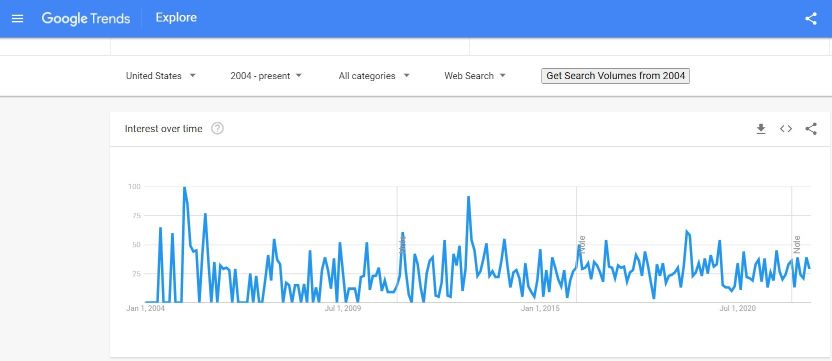

If you’re wondering whether you can use a regular propane tank on a forklift, the answer is no. Regular propane tanks are not designed to be used with forklifts and can pose a serious safety hazard. Forklifts require special propane tanks that are designed to be used with forklifts. These tanks have different fittings and valves that are necessary for safe operation of the forklift.
If you are using a propane-powered forklift, you cannot use a regular propane tank. The tank must be specially designed for use with forklifts. These tanks are typically much larger than regular propane tanks and have a different type of valve.
The propane itself is the same, but you cannot switch the tanks
If you have a regular propane tank and a forklift that uses propane, you cannot switch the tanks. Yes, the propane gas being used itself is the same, but the tanks are not. The tank on a forklift is designed specifically for forklifts and is not interchangeable with a regular propane tank.
Forklifts require a much larger amount of propane than a regular tank can provide, so using a regular tank will not work. In addition, forklifts have different connections and valves than regular tanks, so even if you could get the propane from a regular tank into a forklift tank, it would not be able to be used by the forklift. Here’s an article on how to choose a forklift propane tank.
Forklifts are liquid-fed and not vapor
Forklifts need liquid propane and forklift tanks have a dip tube inside so they are fed liquid propane. The dip tube is a small, metallic tube that runs from the bottom of the tank to the top. The purpose of the dip tube is to ensure that the forklift gets a steady supply of propane. If the dip tube is not working properly, the forklift may not get enough propane and may stall. If this happens, it can be very dangerous.
When a forklift is being used, the operator will need to keep an eye on the level of liquid propane in the tank. If the level gets too low, the forklift will stop working. To refuel the forklift, the operator will need to open the valve on the tank and insert the refueling hose into the fill port. The operator will then pump liquid propane into the tank until it is full.
It is important to note that forklifts need to be regularly serviced in order to ensure that they are safe to use. This includes having the propane tank inspected and refilled as needed.
HD-5 grade propane is used for forklifts
HD-5 grade propane is used for forklifts because it has a higher vapor pressure than commercial grades of propane. This means that HD-5 can be used in a wider range of temperatures, making it ideal for forklifts that operate in both hot and cold environments. HD-5 also has a lower freezing point than commercial grades of propane, so it is less likely to cause problems in cold weather.
HD-10 grade is used in common applications
HD-10 grade propane is a type of liquefied petroleum gas (LPG) that is commonly used as a fuel for ordinary application such as BBQ grills. It is also known as “bulk propane” or “tank propane” and is typically stored in large tanks or cylinders. HD-10 grade propane has a higher vapor pressure than other grades of propane, making it ideal for use in BBQ grills.
This propane provides a consistent, high-quality flame that will give your food the perfect cooked flavor every time. HD-10 grade propane also burns hotter than any other type of propane, so it’s perfect for searing meats or getting those perfect grill marks.
Alternatives and Solutions
For those considering the use of regular propane tanks on forklifts, it’s essential to be aware of the potential consequences and explore alternatives and solutions. Let’s delve into some of these:
1. How to identify the right tank for your forklift
Regular Propane Tanks:
- Identification: Usually marked with labels indicating their intended use (e.g., “For Grill Use Only”). They may have specific branding, design features, or warnings pertaining to their primary application.
- Limitations: They lack the required flow rates, fittings, and durability needed for forklift operations.
Forklift Propane Tanks:
- Identification: Often bear specific labels or markings indicating their design for industrial or forklift use. Their shape, fittings, and design are optimized for horizontal placement and quick connection to forklift systems.
- Selection Guide: Always consult the forklift’s user manual or the manufacturer’s recommendations to ensure the appropriate tank type and size is chosen.
2. Retrofitting options and their feasibility
Regular Propane Tanks:
- Retrofitting Feasibility: Retrofitting a regular propane tank to suit a forklift’s requirements can be challenging and might compromise safety. It often involves adjusting the valves, fittings, and potentially the internal mechanisms.
- Risks: Modifications can compromise the structural integrity of the tank or lead to malfunctioning valves, increasing the risk of gas leaks or other hazardous situations.
Forklift Propane Tanks:
- Optimized Design: These tanks are already tailored to meet the forklift’s needs, negating the necessity for retrofitting.
- Cost-Effectiveness: While retrofitting might seem like a cost-saving measure, investing in a designated forklift propane tank can save on potential repair, replacement, or liability costs in the long run.
3.The role of suppliers and manufacturers in ensuring correct usage
Regular Propane Tanks:
- Supplier Responsibility: Suppliers should clearly label and provide information on the intended use of their tanks, helping consumers make informed choices.
Forklift Propane Tanks:
- Manufacturer Guidance: Manufacturers should provide clear guidelines, labels, and user manuals to ensure end-users are aware of the tank’s intended purpose.
- Supplier Training: Suppliers can offer training sessions, workshops, or informational materials to businesses, ensuring the proper usage and safety protocols for forklift propane tanks.
While the idea of using a regular propane tank for a forklift might arise from the desire to save costs or convenience, the potential risks and inefficiencies make it a suboptimal choice. By adhering to manufacturer guidelines, exploring suitable alternatives, and leveraging supplier expertise, businesses can ensure the safe and efficient operation of their forklifts.
Is Forklift Propane the Same as BBQ Propane?
Forklift propane and BBQ propane are both derived from natural gas, primarily composed of methane, making them essentially the same fuel. However, their usage, storage, and distribution methods differ.
- Usage: Forklift propane is used in industrial environments, whereas BBQ propane is for residential use.
- Storage: Forklift propane tanks are larger compared to the smaller canisters for BBQ propane.
- Distribution: While forklift propane is typically delivered in bulk to businesses, BBQ propane is often available in small cylinders at local stores.
Both types are categorized as liquefied petroleum gas (LPG), a blend of butane and propane. Propane’s non-corrosive nature makes it suitable for indoor forklifts, while the smaller canister size of BBQ propane offers portability for grilling.
Can You Use a Forklift Propane Tank on a Grill?
Interchanging propane tanks for grills and forklifts isn’t advisable. Forklift tanks are made of thicker steel, designed for heavy-duty use, and have different valves compared to grill tanks. Furthermore, they contain more propane, posing a risk if used on grills.
Using forklift propane tanks on grills can be hazardous, may not meet safety standards, and could void grill warranties.
To Make a Conclusion
It’s crucial to note that while it’s technically possible to use a regular propane tank on a forklift, it’s not recommended due to safety and efficiency reasons. Forklift-specific propane tanks are designed with features that prevent fuel spillage and promote proper fuel usage. They have in-built safety valves and fittings, that ensure the propane is released at a regulated rate to reduce the risk of accidents and boost the machine’s performance.
Using a regular propane tank, on the other hand, may lead to operational issues, safety risks, and potential legal implications, especially if an accident occurs due to the inappropriate tank. The compliance with Occupational Safety and Health Administration (OSHA) regulations is paramount in industrial settings, and the use of a non-forklift propane tank could potentially violate these safety standards.
Before opting for a cheaper or readily available solution like a regular propane tank, consider the long-term implications. The potential for reduced efficiency, equipment damage, safety hazards, and non-compliance with safety regulations outweighs any immediate cost benefits. It’s always advisable to use a tank designed for your specific equipment – in this case, a forklift propane tank.
In essence, understanding the importance of using the right propane tank for your forklift is critical for your business’s safety, efficiency, and regulatory compliance. When in doubt, consult with a propane or equipment professional to ensure you’re making the right choices for your operations. Remember, safety and efficiency should never be compromised for cost-saving measures.
By focusing on the correct equipment and adhering to recommended safety standards, you can optimize your forklift operations and ensure a safer and more productive working environment.


Mike is an experienced propane technician with over 15 years of professional experience in the field. He has dedicated his career to helping customers with their propane needs, from installation to maintenance and repair. Together with Jeremy, he co-founded this website to provide useful information and guidance to customers seeking reliable propane services.



